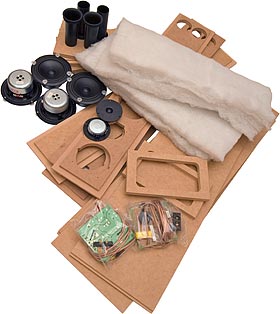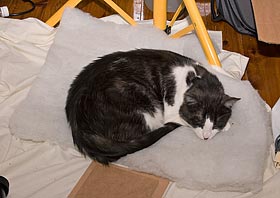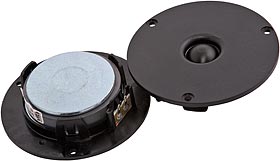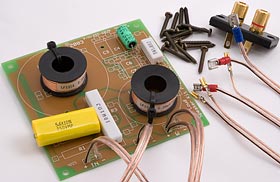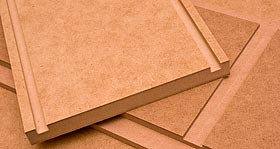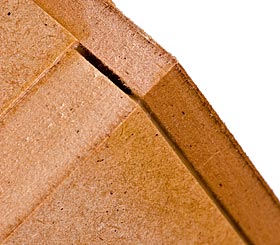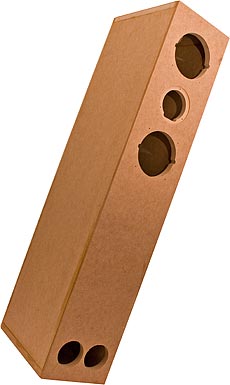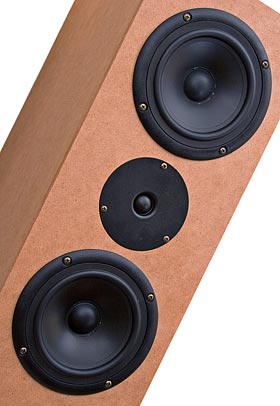
The Loud Speaker Kit F5 speakers
Review date: 10 April 2006 Last modified 22-Feb-2013.
Regular readers will know that I'm a fan of kit speakers.
They're not the only way to go if you want quality audio on the cheap, but they're a very good bet.
You just buy a kit, and devote a few hours to putting it together using no tools more complex than glue and a screwdriver, and then you've got a good set of new speakers that cost you, generally, half what they would have if you'd bought them assembled. At the very least.
The bargain isn't quite as good as it seems at first, because the basic version of kit speakers usually leaves you with plain MDF boxes without even paint on 'em, but (a) some people don't care, and (b) there are various finishing options, some very easy, and I'll talk about them later.
Even when you take finishing into account, and spend some extra time and money on it, you're still likely to end up with a total outlay not far over half of what you'd pay for similar pre-built speakers
And, if you get a decent kit, it really is surprisingly easy to assemble.
Which brings me to m'verygoodfriends at The Loud Speaker Kit. They sell several neat speaker kits for Australian buyers.
[UPDATE: As of 2012, The Loud Speaker Kit were out of business; as of early 2013 they're back under new management, though not with a full line of products yet. There are several other kit-speaker companies both here in Australia and overseas. It can also be easier than you'd think to design your own speakers from scratch!]
(Shoppers outside Australia should meditate upon the wisdom of shipping 34 kilogram parcels from places they've only read about in magazines. It is, of course, possible to order speaker kits from other countries, and not a dumb idea financially if the kits themselves are quite expensive, or you intend to make your own cabinets. But The Loud Speaker Kit don't sell driver-only kits, and they don't ship outside Australia.)
I've previously reviewed a couple of LSK kits. The little M4s were first; that review's here. Then they laid an S250 subwoofer on me; that review's here.
The kit they sent me to check out this time is the F5 Mark II, their basic floor-standing tower speaker from the "Cinema Series", which contains their speakers that're meant to compete with the gear the big chain hi-fi stores sell.
The F5 II goes for $AU899 a pair, and is meant to be "a very 'commercial' speaker". With "somewhat overstated" bass. The F5s are, it would appear, "a huge hit" with the "under 21 year old" customers.
Well, all right then. I'm, ah, "hip" to the "jive" of the kids of today. Man.
Is the F5 a mere shag-pile-flapping, parent-annoying, OONTS-OONTS-OONTS making kid-pleaser, or is it a perfectly good option for the money?
I've reviewed speaker kits before, so this time I'm going to go into each component and concept in more detail, and also talk about other sensibly priced audio options.
This is partly because of my well-established enthusiasm for rambling on, partly to give people who're in the wrong part of the world to buy these speakers a reason to read this review anyway, and partly because there are some things about sound in general and speakers in particular that it really helps to know. When you know which bit does what, you'll be better equipped to get yourself speakers that do what you want them to do, without paying more than you need to.
Bits and pieces
The kit for both F5s comes in one long, weighty box, which is sensibly packed. The drivers (woofers and tweeters) come in their own boxes within the main crate, but it's still asking for trouble if you just throw the various bits of two speakers this big into a crate for shipping - planks of MDF will slide around inside and beat weaker components to death.
The LSK crate isn't like that. All bets are off if it falls off the back of a delivery truck, but despite the fact that it's not bulked out with gobs of extra packaging material, it looks very likely to reach the customer intact.
You get a bunch of panel pieces, all rebated around the edges to fit together neatly, a couple of bags of electronics and fasteners, the abovementioned drivers, four push-in plastic ports (for the F5s have a vented box), printed instructions (not shown in the above picture; you can download the instructions in PDF format) and a couple of large pieces of fluff.
Persons unschooled in the ways of speaker construction may mistake the fluff for packaging material, but it's actually got an acoustic purpose. "Wadding" of one kind or another is used in speaker boxes to damp unwanted resonances, slow air flow, and generally soak up sound. Wadding can, for instance, make a sealed box behave as if it's bigger than it really is, giving better bass response, at the price of a bit of efficiency.
The LSK fluff is polyester wadding, which is far and away the most popular material for loudspeaker lagging. Its acoustic qualities are only OK - it doesn't soak up sound as well as, say, long fibre wool or various bitumen-enhanced concoctions - but every other department, it's great. It doesn't, for instance, want to slide into a pile in the bottom of the speaker like wool or cotton waste. Polyester's also quite cheap, though nothing's as cheap as cotton waste, which you'll find in the very cheesiest of cheesy speakers that, nonetheless, want to make an effort and have some lagging in there.
Polyester burns, but doesn't sustain a fire. And, unlike glass fibre batts, polyester doesn't break down into tiny bits of super-sharp glass dust that worm their way into the very skeleton of anybody who works with it without gloves, and puff in a possibly carcinogenic way out of the speaker ports with every bass note.
This particular fluff is made by Tontine in Melbourne. A cursory examination of the Tontine site will reveal that they are not, exactly, audio engineering specialists. They're more into what you might call the soft and squishy thing industry.
Polyester fluff is, indeed, used to stuff cushions and toys and such. It's my opinion that it's too scratchy to be comfortable without a cover...
...but not everyone agrees.
The F5 tweeters are Vifa soft dome units. Which is good.
Mechanically, soft dome tweeters like this are the same as any other ordinary magnetic voice coil driver. They're just "all dustcap", with no cone on the outside of the radiating surface.
Soft dome tweeters really are soft, as many surreptitious speaker-pokers have discovered. They're actually made from silk fabric doped with various mystic damping compounds; you can prod the dome and it'll give and bounce back to its original shape, provided you haven't prodded it too hard. At low frequencies, an audio radiator made out of stuff this soft behaves atrociously badly, but at the high frequencies a tweeter's supposed to reproduce, modern soft domes act, in theory, like a lovely inflexible perfect radiator.
(In practice, things are of course much uglier.)
But soft dome tweeters are, still, well established affordable hi-fi options, and Vifa are a rightly famous brand.
Not exactly a famous company any more, though, because they're now part of a blob called Tymphany, the other half of which is similarly famous brand Peerless, who make...
...the F5 bass drivers.
Each F5 has two woofers, one above the tweeter and one below. This is called a D'Appolito configuration, after its rather famous inventor, and it helps - in theory - to blend the sound from the three drivers into one horizontal fan, which seems to come from a smaller source than is really producing it.
(Can that idea be extended to larger numbers of drivers? Yes, it can.)
Two-small-woofer designs also let the speaker be tall and thin, with a small footprint. This gives larger speakers what used to be called "spousal approval factor", by people much less enlightened than me.
Two woofers and one tweeter also, technically, makes the F5s only "two way" speakers, though each has three drivers.
The "way"-ness of a speaker doesn't mean anything in and of itself. Most speakers these days are "two-way" with two drivers or "three-way" with three, but single driver speakers exist, as do two- or three-way speakers with startling numbers of drivers. There was also something of an arms race in the consumer mid-fi market in the '70s and '80s that resulted in four- and five-way systems.
There's some justification for this sort of thing, since more "ways" means each driver can be devoted to a narrower frequency range, presumably the range that it can reproduce best.
In practice, it's difficult to design a good crossover for multi-way speakers (the crossover is the circuit that delivers the right frequency band to the each driver), and lots of drivers in an ordinary box speaker makes for a smeared sound source, which hurts stereo imaging.
Two-way systems have to reproduce treble, midrange and bass with those two drivers (or only two types of driver, anyway), and it's practically impossible to find an affordable pair of drivers that can cover the canonical 20Hz to 20kHz range of human hearing.
The usual solution to this problem is to simply not cover that whole range. Super-low bass is plain impossible with small drivers in conventional speakers, but that's OK because a lot of music doesn't even contain low bass, and people can always add a subwoofer if they like.
Really high treble is of questionable usefulness too, but it's now quite easy to find tweeters that do a good job over the entire range found in most program material, so that's well enough covered these days.
Actually getting flat response all the way to 20kHz is prodigiously difficult, but treble bounces off stuff in the average room in such a way as to deliver bizarre frequency and phase response oddities anyway, so in practice the mountain-range response graph of even high quality tweeters doesn't matter.
Obsession with frequency response is symptomatic of the disease that, among other things, led to those seven-way monstrosities in 1979. All other things being equal, more undistorted frequency range is great to have. But it's possible to make great sounding speakers that only have a single widerange driver in them, with a useful frequency range from, oh, maybe 80Hz to 12kHz, tops.
Actually, a good cabinet can make even a five dollar paper-surround 1980-factory-stock car audio six-by-nine-inch driver sound quite nice. You won't get sparkling high treble or floor-shaking bass, but single quite crummy wideranges in good cabinets can, within their limits, deliver much more accurate stereo reproduction than most people's "hi-fi" speakers.
Modern high-spec widerange drivers, installed in cabinets of varying weirdness, can sound amazingly good. More drivers are not necessarily better.
Anyway. Um. Where was I?
Oh yeah, the woofers.
The four little round things stuck through the mounting screw holes on each of these drivers are removable protector doodads that stop the roll surround around the cone from being squished if you put the driver on a surface face down. The woofer that is face down is showing off its shielded magnet. It's becoming less important to have magnetically shielded speakers, as the home theatre nuts transition to plasma screens and projectors that don't suffer from magnetic image distortion like CRTs, but these drivers are shielded just the same.
The tweeters aren't shielded, and they've got big enough magnets that the F5s actually will influence a CRT image if you put them right next to the TV. So, you know, don't do that.
(Even unshielded speakers don't have anything like a strong enough external magnetic field to influence things like tapes and hard drives. CRTs are very touchy.)
The Loud Speaker Kit describe these drivers as having a diameter of 135mm, which is 5.3 inches. That doesn't sound like a lot compared with the 12 and 15 inch bass drivers that inhabit the average university student's pair of neighbour-annoyers, but - you guessed it - there's more than meets the eye here, as well.
For some reason, speaker buyers respond positively to speakers with more inches of woofer, so people who sell speakers are often... generous... when specifying that dimension.
The overall diameter of the plastic rim around the F5 bass drivers is nearly six inches, and some marketers would be happy to call them six inch drivers.
Back in the real world, though, these are about 4.9 inch drivers, if you measure from the very edge of the wide lip around the rubber roll surround, and apply a bit of creative parallax error.
If you measure from the edges of the roll surround itself - the outermost part of the driver that moves - it's more like 4.3 inches. If you measure from the inside of the roll surround - the outermost part of the driver that moves air to make sound in the way the designers intended, and the diameter you measure when you're doing the Vas (Volume Air Space) part of driver spec calculations - it's about 3.6 inches.
So, being fair, this is a driver in the four, not five, inch size class.
Mere size does not, actually, matter a huge amount for a bass driver, unless all other things are equal. They seldom are. These nice European-made drivers, for instance, cannot by any normal means be induced to deliver bass below about 35Hz, have pretty ordinary efficiency, can handle a mere 40 real watts, tops, and yet each retail for the kind of money people are used to paying for big ugly windscreen-cracking subwoofers that can play much lower and louder.
There are reasons for this.
As you'd expect, the Peerless drivers have higher fidelity - they more accurately reproduce the incoming signal, at least that portion of it that isn't too low for them to play. Part of this is because they're smaller; smaller bass drivers weigh less and can be pushed around more accurately by their voice coil.
(There's a trade-off here, as well - a woofer with a heavier cone will have a lower resonant frequency and thus be able to play lower. So some lower-fi sub-bass drivers are deliberately made with much heavier cones than are strictly necessary. This strategy is bad, bad news for audio accuracy, though.)
The little Peerless drivers also have a highly compliant rubber roll surround, so they can move more freely fore and aft than can cheaper speakers with stiffer suspension.
(Driver "throw", the total distance the cone can move fore and aft, also strongly influences performance. Very long throw drivers, again, have more bass but lower fidelity, all other things being equal.)
And there are, of course, two bass drivers per F5 enclosure, giving the actual piston area of a single six-inch-class driver. But the bigger driver would be more efficient and have a lower resonant frequency, all things being equal. And on it goes. A voice coil loudspeaker is, essentially, a simple enough contraption that you can make your own at home, but they're a pretty mature technology now, and a lot of fancy figgerin' goes into the design of even pretty mainstream drivers like these.
If you're not willing to geek out utterly and figure out all of the variables and what they mean, getting excited about woofer size is a waste of time. But don't let me stop you.
Here are the rest of the bits that go into making the speakers. One crossover board (obviously a one-size-fits-many board that's not heavily populated with components in this case), one bunch of screws, one simple plate with a couple of terminals on it, suitable for use with bare wires or banana plugs.
All sorts of speakers these days, including a lot of real cheapies, have dual terminal plates on the back - one set of "treble" terminals, one set of "bass" ones, typically joined with a metal strip so you can hook up only one pair of wires.
In some cases, these dual terminals are 100% decorative, because they only hook up to two wires on the inside.
In other cases, the terminals might as well be decorative, because people "bi-wire" their speakers with one wire-pair going to each terminal set, but connect those wires to only one amplifier output, justifying their actions with the usual pseudoscientific audiophile blather.
If, however, each set of terminals actually hooks up through its own separate filter network inside the speaker that then drives a different set of drivers from the other set of terminals, then you can "bi-amp" your speakers, with one amplifier for the treble and another for the bass.
The benefits of doing this, with speakers that still have a conventional crossover that's been chopped into two or more separate circuits, are questionable. The full-Monty version of the idea, though, is to use an "active crossover", which uses precision small-signal components to do the frequency-separating job before the amplifier, rather than sending all of the frequencies to the speaker and having big coils and caps inside it separate the frequencies at much higher power levels. This lets you use much fancier crossover designs, and even adjust the crossover on the fly.
More prosaically, active crossovers should also last longer, as the large value electrolytic capacitors that practically all conventional crossovers use inevitably drift from their correct values as they dry out.
All of this stuff can be done quite cheaply, but usually isn't. You could base such a system on the F5s without much trouble, by installing a dual terminal plate and wiring it straight to the drivers, and you can make active crossovers on a breadboard with $10 worth of components. This would, of course, deprive the resultant sound of the special glow that only comes from gear that costs as much as a house.
Putting 'em together (finally)
Like the other LSK kits, the F5s use their "unique JigLock™ system" to make it easier to fit all of the panels together exactly. I don't know about the whole "unique" thing, since I think fitting the rebated edge of one board into a slot cut in another is a technique that's been around for a while now, but the LSK kits are, nonetheless, good.
The only problem people commonly face with kits like this is that the panels fit together a bit too well. Assemble five sides of a box, and the sixth one won't fit unless you drop it in dead flat.
It's easy enough to get around these sorts of problems, though, and it really is no big deal to assemble these sorts of kits, even if you've never done it before. Read the instructions all the way through first, dry-fit the parts before you start spraying PVA glue all over the place, and you'll be OK. You'll probably use too much glue, but PVA's easy enough to remove.
(LSK warn you, in the instructions, not to use newspaper to keep glue off whatever surface you're working on, because it'll leave you with inky marks on the speakers, or possibly even chunks of newspaper papier-mâché stuck to the seams. I've used plain paper under speaker kits before, and that's OK, but I built my F5s on a tablecloth made from a cut-open garbage bag, which worked very nicely.)
My F5 kit was an early version of this new Mark II incarnation of the speaker, and had a couple of glitches. I did my very best to make them worse.
This, for instance, is the edge of the brace that reinforces the box, just below the driver holes. Note the overhanging surface sheet of the MDF. A flaw like that isn't very important for an internal component like the brace - if it stops the brace from fitting properly then you can just pare the overhang off with a utility knife - but, much more annoyingly, both braces were also too thick to fit into the grooves on the insides of the front and back panels of the boxes. A certain amount of sanding was therefore called for - but, since it didn't matter what they ended up looking like, I just whittled the buggers.
And, moreover, there were only grooves on the front and back panels, instead of the all-around groove, including both side panels, that was promised in the instructions. The braces weren't too wide to be installed - they were made for this kind of setup, not for an all-around groove - but newbies unaccustomed to discrepancies between instructions and reality could have been concerned. The Loud Speaker Kit assure me that all later F5 IIs match their instructions.
And then, there was this.
One speaker went together neatly (except for the middle brace), everything lining up nicely; one ended up with this misalignment between the top and side. I assembled both speakers on the same nice flat table, and I couldn't see any warping of the panels of this one, but it just didn't quite line up right.
Here's the result; a gap between the top panel and the front one. I think I made the problem a bit worse than it had to be by, um, continuing my accurate simulation of a person unstudied in the ways of cabinet making, but there was no way to completely eliminate the gap.
But I'm going to give LSK a pass on this, too, because (a) as mentioned above, this was an early F5 II kit, and they said they'd never seen such a problem on any of the retail ones, and (b) they've got a satisfaction guarantee that, at the very least, gives you your money back on any kit you don't like, for any reason. They also offer just replacement boxes, if there's something wrong with the ones in your kit. You do have to pay to send defective stuff back to them, though.
I built this second speaker faster, by ignoring the instructions (stay with me, here) and building it up from its back panel. That was faster, and didn't require me to keep turning the increasingly awkward box-in-progress around, but also offers more chances for things to go wrong, especially if your workbench isn't quite level.
What order you put the pieces together in, though, does not affect their dimensions, and no amount of squishing and sliding would get rid of the gap.
So I just caulked the gap up with plenty of PVA glue, and ended up with a seam that was perfectly well sealed, without any special clamping.
(You can use sash clamps if you want while assembling LSK kits, and that'll get you better joints. But speakers aren't ladders; they don't need to be terribly strongly built, so any continuous air-tight glue joint will do. When building previous LSK kits I combined the time-honoured piling-stuff-up-on-top technique with a clamp or two; when building the F5s, I only used weights on top. Came out fine.)
You have to be close to the speaker to even see it the gap...
...and the gap faces upward, not forward.
This is the point in the construction process where you do your painting or veneering or whatever. Or where you don't.
(It's possible to build the speakers and finish them later, though. You could do it by masking off the drivers, or more safely by uninstalling them.)
The instructions say "you may choose" to stick the crossover boards to the inside of the cabinet instead of just leaving them bouncing around in there. I think you definitely should glue 'em down; it's surprising how much wiring you can leave loose inside a speaker and, with a bit of artistic wadding-weaving, never hear anything buzzing, but a darn great crossover board ought to be held down, if you ask me.
I blobbed some hot-melt glue on the backs of the boards and pressed them into place. Easy.
The wires from the boards, by the way, terminate in connectors that press-fit onto the spade lugs on the drivers. These things are electrically perfectly OK, but they're built down to an (extremely low) price, and so are commonly too loose or too tight. LSK suggest you solder them on for a really secure connection.
A good crimped connection, however, can easily be better than a soldered one (there may be solder on top, but only to protect against corrosion), so I just crimped the terminals good and hard. I used an actual crimping tool (which wasn't really made to do this job), but pliers will be adequate.
After hooking the drivers up, you stuff the polyester wadding where the instructions tell you to, then screw the drivers into place. This part of the installation's dead easy, and the result...
...is a pair of speakers.
The whole procedure, my niggles aside, is really not hard at all. This is not proper woodworking - it's a cross between Lego and really good flat pack furniture, with lashings of PVA.
In a well thought out kit - loudspeaker, R/C tank, whatever - everything fits together in such a way that it's not possible to put anything backwards or upside down and still have the kit fit together at that point. You shouldn't be able to get something wrong now and not be able to see until seven instruction steps later, whereupon the glue's set and you're screwed.
The F5s are almost that foolproof. Especially talented constructors could, I suppose, get the front, back or side panels the wrong way up and therefore end up unable to install the centre brace
That's about it, though. The "Jig-Lock" setup makes it impossible to make other kinds of mistakes, like putting panels on inside out and then discovering that the tweeter rebate's on the wrong side of the board. That sort of thing is just not going to happen, even if you're me. And in high school woodwork, I managed to make (well, half-make) a stepladder that'd only work if you took it to the same universe as Escher's Waterfall, so I know about screwing things up.
Listening
When The Loud Speaker Kit told me the F5s are meant to be "a very 'commercial' speaker", I didn't think it boded well.
Mass market speakers are, frequently, made to impress the average listener in the shop. A lot of boom really helps in that department, so a lot of them have a frequency response plot with a big ol' hill in the low frequencies. The larger ones really do have considerable bass response, but at a terrible price. They're the audio equivalent of a dragster - does one job well, does everything else very badly.
Big boomy boxes bought in a place that also sells refrigerators may be fine for a party, but they're fatiguing to listen to the rest of the time, as your brain works to fill in their various shortcomings. This is why you can listen to music on a little portable radio with zero response below 250Hz and no treble much above 10kHz, yet think it sounds pretty much OK.
This isn't airy-fairy audiophile nonsense; there's a lot of room for delusion when you're comparing one good speaker with another, but anybody with functional ears can hear the difference between a good speaker and a honk-and-rumble special from Mentally Ill Herbert's House Of Suspicious Bargains.
Fortunately, The Loud Speaker Kit's idea of "commercial" isn't the same as Herbert's. That complicated graph I linked to earlier shows how the F5s are tuned. Instead of a big one-note-bass hump somewhere down around the kick drum region, they use what's called "Extended Bass Shelf", or EBS, tuning (or, if you want to sound all technical, "alignment").
EBS isn't hugely different from ordinary vented box tuning, and it's no harder to design and make, except you need a somewhat larger box. It's a popular tuning scheme for giant subwoofers, but it works fine with smaller boxes and drivers too.
EBS systems can be coaxed into flat response by judicious use of equalisation, but that's pretty much reserved for enthusiasts with time on their hands, and PA applications, which generally push EBS to the limit and may be starting to grow the dreaded response hump.
Everybody else just uses mild EBS tuning, and enjoys bass that's mildly emphasised, yet quite musical. Along with the bit of free bass you pretty much always get from room resonance, this sort of tuning gives a very good trade-off between distortion and bass response.
There are, of course, umpteen other ways to make bass, and some of them are well within the range of the unaccomplished cabinetmaker.
You can, for instance, make a speaker with a small sealed box whose bass driver only outputs bass below the system's resonant frequency (Why doesn't everybody do that? Because you need an imposingly boosted bass signal and a buttload of amplifier power for ordinary output levels. The system's efficiency sucks.)
So what do the F5s actually sound like, I hear you ask.
Well, they're no better than I expected. But I've built LSK kits before, so my expectations are high.
I started the listening tests with material that disagrees with "commercial" speakers. Your surprisingly expensive classic jazz, your harpsichord-y baroque classical; that sort of thing.
You know what? The F5s weren't bad at all. They're not fantastic for this kind of music, but I'd be quite confident about stacking them up against most of the world's $AU800 pre-built speakers. Compared with the speakers most people use, the F5s are a revelation.
The big-woofered three-way "college student specials" on which certain companies have built their reputations have much more bass boost than the F5s, and often have pretty ordinary midrange drivers as well, and so suck like unto a severed deep-sea vacuum pipe for anything but the brainless boom-tish they're made to play. But the F5s are not like that.
It's arguably better to have no bass than heavily boosted bass when you're listening to light jazz with a double bass in it, because boosted bass will blow up that big string instrument into a radioactive monster that flaps the speaker cones around so much that the whole midrange turns into a smear. The same goes for light classical, though not as badly, because a lot of light classical music has pretty much no bassline at all most of the time. If nothing tickles the boosted section of the response plot, it can't do any harm - though if you're a vinyl enthusiast, you really do want to make sure your rumble filter's on.
The quality drivers and D'Appolito driver arrangement seem to do for stereo imaging what they're meant to. I didn't try the F5s in different rooms or tweak their position and aim for hours, but there didn't seem to be any very pressing reason to fool with the setup unduly; these speakers don't have a narrow "sweet spot", out of which the music doesn't sound right. Sit the F5s on the floor and their drivers will be more or less at the right height to shoot at your ears when you're seated on something comfortable.
If you want to turn the F5s - or various other bassy ported speakers - into something better suited to light music, by the way, you can, by increasing the resistance of the ports. This is a highly technical tweak, not to be attempted by beginners.
The procedure is as follows:
1: Get something.
2: Stuff it in the ports.
All sorts of substances will work for this - paper towels, old socks, or of course polyester fluff - and impede the flow of air through the ports to different degrees. It's surprising how much difference very lightweight plugs can make. This can also provide a quick fix for awful cheap subwoofers - stuff the port(s) and the sub will pretty much shut up entirely, because all it has is port resonance, leaving you listening to the satellites plus a bit of more-or-less-sealed box bass from the muffled sub.
So much for the sounds that the F5s aren't meant to be good at. On to the sounds they're made for.
The F5s did, as you'd expect, surprisingly well on my low bass test tracks.
The one with the low-C 808 drum in it, as usual, kinda lost the bottom note. But that note's 32.7Hz with standard tuning, and the F5s are only quoted as having useful bass response down to 36Hz. As normal for speaker frequency range measurements, that point's where the F5's response is 3dB down, never to come back up.
Three decibels is a power ratio of two to one, which is an easily audible difference; the minimum audible volume difference is usually quoted as being 1dB, which is a power ratio of only 1.25 to one. What this means is that speaker response is considerably reduced at the -3dB point - there's still enough response for it to mean something, but you're more or less at the point where other frequencies in ordinary program material will drown out the bass.
If you hook up an audio signal generator to your stereo and wind it lower and lower, you'll still be able to hear something a fair few notes below the official bass limit, if you turn the volume up far enough. Unless you artificially boost that quiet low response, though, it's good for nothing with ordinary program material. And if you do boost low response enough to noticeably increase bass, your woofers will be hitting the stops at pretty low volume settings.
Speakers that use special equalisation to make up for driver limitations can work quite well. Bose's 901s work that way. They've got smallish boxes containing nine four inch drivers (eight of which shoot backwards), and they come with an equaliser module that lets them deliver full-range audio - though Bose have the same attitude to actual response specifications that Rolls-Royce always used to have to horsepower.
(901s have been selling well for decades, thereby disproving the power of fervent prayer by audiophiles to cause a product to be swallowed up by the earth.)
Without this kind of jiggery-pokery, though, you can't push the bass (or treble) any further than it wants to go. The F5s' EBS tuning makes response drop off faster than usual below the 3dB point, so they've got pretty much no response at all below 36Hz.
That's still very impressive from these drivers, though. My psychic powers, and this PDF file, tell me that these 14SG08 drivers are classed as "mid-woofers", and have a resonant frequency of 55.8Hz (the bass driver in the S250 subwoofer has a resonant frequency of 21.7Hz, well over an octave lower).
The F5s' bass is quite remarkable, for a small-footprint speaker like this.
If the mention of Montreux makes you think less of the Jazz Festival and more of the gambling house dying with an awful sound, you may assume that something with a couple of little five-inch woofers in it just isn't going to cut it in the bass department. But there are plenty of decent big-box speakers that only work about this well. If you're thinking of buying F5s and a subwoofer, hold off on the sub purchase until you've listened to the F5s by themselves.
LSK put the F5 in their "Cinema Series", and they are indeed darn good speakers for the discerning but not particularly wealthy home theatre enthusiast. Just by themselves in a stereo pair, driven by any old ordinary two channel amplifier, they'll give you a far better listening experience than any $1000 all-in-one home theatre speaker package.
Yes, an all-in-one package does give you a centre speaker, a subwoofer and surround speakers. And some of the better "multimedia" surround speaker rigs, like Logitech's not-too-expensive Z-5450s, are not the same complete piles of poo as similarly priced "home theatre" setups (though I still prefer the old Z-560s).
But, really, you'll do better to buy your surround setup piece by piece.
You can get away with pretty crappy speakers for rear surround duty, but if you're going to have a centre speaker, it needs to have good midrange response, and not be some crummy $3 driver in a plastic box. Likewise, if you're going to have a sub, it needs to be able to play more than one bass note. You honestly are better off just not doing surround at all if you can't afford decent gear to do it with.
If you insist on feeling all of the thud and blunder of action movie soundtracks, the F5s won't cut it by themselves. Honestly, you'll never miss a subwoofer for most movie viewing if your front left and right speakers are good, and you should do without a sub if you're sharing a building with people whose home entertainment hours do not necessarily coincide with yours. But low frequency effects tracks commonly contain 20 to 30Hz thumps and rumbles, which a good sub can reproduce and the F5s can't.
For the rest of the music I tried them on, the F5s acquitted themselves very well. I'm not going to start babbling about articulation and musicality; they just sound good. Some of that goodness no doubt comes from the mild "loudness button" effect created by the boosted bass and "recessed" midrange, which suits lots of popular music well, but that effect isn't big in the F5s.
Value
You can get pre-built speakers for a lot less than $AU899 a pair. You can get a rather nice pair of bookshelf speakers for that kind of money, or indeed for a few hundred less. If you want a beautifully finished product without any fooling around, then pre-built speakers are obviously still the way to go.
If you don't care too much about the finish, though, or are happy just to use a couple of cans of spray paint on each one, I think the F5s really do offer excellent value.
The value equation changes a bit, but not a lot, if you want professional looking speakers. The Loud Speaker Kit's vinyl veneer gives a decent result with not too much effort - they also sell a vinyl edge trimmer that actually does appear to work better than the alarming bare blade of your choice. The LSK guides page covers other finishing options.
As well as other tips pages, LSK also have forums with more help and a fair number of people talking about LSK and other products. Poke around there for a while and you'll find people who build their kits more carefully than I do, modified versions, project logs, and the occasional coffee table that things always fall off of.
There's considerable enthusiasm on the forums for other cheap audio gear, like the TNT FleXy Table (just one of their various projects, some more complex than others).
Oh, and suggestions about defrauding hardware stores.
LSK also have grille kits, but that's just mounting hardware and cloth; you have to supply your own frames.
(LSK also, by the way, now sell acoustic panels to de-echo the walls and corners of your listening room. Their basic 600 by 600mm acoustic tiles are rather good value, and could also be used to quieten down a computer room. Just don't let it get out of hand.)
There are zillions of other speaker options out there, of course. Even if all you're interested in are speakers that have the same basic layout as the F5s and are made here in Australia, there are a few possibilities.
Krix's Lyrix Golds do probably sound better than the F5s (even if you're a Bass Enthusiast), but they're $AU1500.
Aussie company VAF offer their DC-7s as an easy-to-assemble kit with pre-built nicely finished cabinets, and I think the DC-7s stand a good chance of sounding better than the F5s to most listeners too. But the kit version only saves you $AU200 off the $AU1600 price of the fully pre-built DC-7s, so you'd bloomin' well want them to sound excellent.
Whatmough's Opus 30s are another D'Appolito design with F5-ish specs. They're $AU1800 or so.
If you want to pinch pennies, though, you can get something that sounds considerably better than the average "hi-fi" for a lot less than the price of the F5 kits.
My current computer room sound system, for instance, consists of a Sonic Impact T-Amp (as previously talked about here) and a couple of Gale Gold Monitors, which in no way resemble any speaker currently on the Gale site, but cost me eighty Australian bucks plus postage (down from an alleged $AU249 retail price which, I suspect, is what a bloke in a van would say they were worth).
The T-Amp I had to import, the Gale speakers are sold here in Australia by that time-honoured institution, One Dude On eBay. The T-Amp needs a separate power supply, so I got this, which is efficient, has the grunt to do the job, fits pretty neatly under the amp (though the wiring needs a little custom work if you don't want it to loop around the place), and offers multiple output voltages for running other stuff if you like.
I haven't listened to this setup especially critically, given that it's normally backed by a rousing chorus of PC cooling fans. But it gets the job done, will take line input from whatever audio sources you have, and cost me a total of less than $AU250, delivered. That's the price of a nasty little midi system (which, of course, will have minor details like a CD player included), but the Gale speakers are proper honest little bookshelf units with reasonably balanced output and decent bass for their size, and the T-Amp is clean, more than powerful enough, can run from AA batteries for portable use, and makes me feel all cool.
The T-Amp's nine clean watts per channel into eight ohms also, by the way, makes it perfectly adequate for proper main-sound-system use, even though it's a hilarious little plastic thing that weighs nothing. Nine watts a side won't cut it for party volume if your speakers aren't efficient, but to get twice the volume you need ten times the wattage. Most people would be perfectly happy with T-Amp power driving a couple of F5s in their living room.
The F5s only have a quoted efficiency of 89dB from one watt at one metre, which isn't terribly high but isn't awfully low, either. High efficiency speakers used to be essential if you wanted decent volume, because home amplifiers were all weedy little things that struggled to output five clean watts per channel. Today, pretty much any ordinary home amp can drive these speakers to party volume with no trouble at all.
(Needless to say, LSK will be happy to kit you out with such an amp, with prices starting from a mere $AU499.)
Overall
Do the extra LSK frills, like forum posts explaining the development process, make the speakers sound any better? No. But this stuff does indicate a company that cares about customer satisfaction.
Reviewers like me are, for some reason, surrounded by the kind of Good Consumer Experience Field that usually takes considerable effort to achieve. LSK seem to like pleasing ordinary customers, though.
If your listening tastes aren't 100% Mantovani and Miles Davis, and you want respectable quality on the (relative) cheap, the F5s will give it to you in a package that will fit in anybody's listening room.
If you want a hand-rubbed burr walnut finish, though, it'll be less than straightforward to get it with a kit speaker. On the other hand, if you want hot pink speakers, all you need to do is buy a spray can or two.
And that, of course, is just the beginning. Want cartoon characters all over your speakers? Grab some self-adhesive book-covering plastic and go nuts. Let your toddler decorate them with crayons (before you screw the drivers in, by preference...). Assault them with a blowtorch. Cover them with speaker carpet, purple shag pile, fake fur, real fur, macaroni or seashells.
And, furthermore, until the end of April 2006, anybody who mentions this review when they order a set of F5s will also get free insured shipping anywhere in Australia, worth $AU69. For May 2006, the special offer changes; now, anybody who mentions this review and orders a pair of F5s will get a free pair of M4s to go with them.
(Also, as I write this, LSK have a competition going - sign up for their e-mail newsletter and go into the draw for a free pair of M5 bookshelf speakers!)
Without those little extras, the F5s still score highly with me. With them, they're definitely recommended.
Review speakers kindly provided by The Loud Speaker Kit.
[UPDATE: As of 2012, The Loud Speaker Kit were out of business; as of early 2013 they're back under new management, though not with a full line of products yet. There are several other kit-speaker companies both here in Australia and overseas. It can also be easier than you'd think to design your own speakers from scratch!]

